 |
Watch The Program: Teachers
This hour-long program is divided into eight chapters. Choose any chapter below and select QuickTime or Real Video to begin viewing. If you experience difficulty viewing, it may be due to high demand. We regret this, and suggest you try back at another time. Due to rights restrictions this program is not available for downloading.
Feedback |
Technical Help |
Program Credits |
Program Transcript |
Program Update
|
 |
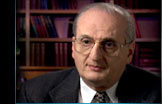
|
The Experimental Drug
This chapter:
discusses Endostatin, a revolutionary, potential treatment for cancer
that could change how the disease is managed. features Dr. Judah Folkman, a cancer surgeon running the clinical trials
for Endostatin. profiles two cancer patients who meet the criteria to enter the clinical
trials for Endostatin. states that it is not yet known whether Endostatin will be effective.
running time 07:15
|
|
watch it in
QuickTime |
RealVideo
|
|
 |
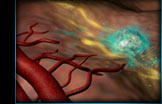
|
Starving Cancer
This chapter:
points out that current cancer treatment involves extreme measures. elucidates that Endostatin kills healthy cells that feed tumors. recounts how Endostatin was developed in Dr. Folkman's lab. explains how Dr. Folkman arrived at his theory that tumors secrete a
mystery factor that triggers blood vessel growth.
running time 09:30
|
|
watch it in
QuickTime |
RealVideo
|
|
 |
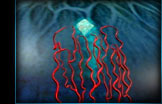
|
Angiogenesis in Action
This chapter:
describes tumor angiogenesis experiments. follows the search for the mechanism of angiogenesis and the factor(s)
that trigger blood vessel growth. explains the lengthy purification process for potential molecules
involved in angiogenesis and their final analysis by molecular size, weight,
charge, and affinity for other molecules. tells that after more than a decade, one protein was purified, put in a
slow-release pellet, and inserted into a cornea where it triggered blood vessel
growth. states that this work may lead to a new way to treat cancer.
running time 06:37
|
|
watch it in
QuickTime |
RealVideo
|
|
 |

|
Preventing Angiogenesis
This chapter:
follows the search for angiogenesis inhibitors during the 1970s using
cartilage from cow bones. describes experiments designed to inhibit vessel growth. reports an accidental discovery that led to the development of an
experimental drug, TNP 470, that could inhibit mouse tumors by 67 percent.
running time 05:50
|
|
watch it in
QuickTime |
RealVideo
|
|
 |
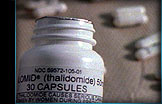
|
New Use for an Old Drug
This chapter:
reports on the search for better angiogenesis inhibitors by looking at
existing drugs. describes how thalidomide was chosen for testing. reports on test results with thalidomide.
running time 06:04
|
|
watch it in
QuickTime |
RealVideo
|
|
 |
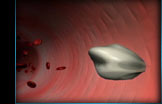
|
How Cancer Spreads
This chapter:
explains how cancer cells travel the bloodstream, lodge in another place
such as the liver or lung, and continue to grow again. describes how in a small percentage of patients, somewhat dormant
metastases come to life when their primary tumor is removed. reports on the discovery that some normal cells secrete angiogenesis
inhibitors. elucidates how primary tumors seem to be the source of the inhibitor.
running time 06:30
|
|
watch it in
QuickTime |
RealVideo
|
|
 |
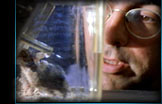
|
Finding New Inhibitors
This chapter:
presents the search for inhibitors in mouse tumors. describes the process of urine collection and protein purification that
led to isolation of the molecule, angiostatin. summarizes research results involving administering angiostatin to mice
with cancer.
running time 05:37
|
|
watch it in
QuickTime |
RealVideo
|
|
 |
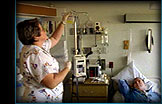
|
Clinical Trials
This chapter:
presents one patient's experience on Endostatin. tells how the angiogenesis inhibitor studies marked the beginning of a
change in how physicians treat cancer. states that at least two dozen drugs that block blood vessel growth
exist, and thousands of researchers are now working on angiogenesis.
running time 05:14
|
|
watch it in
QuickTime |
RealVideo
|
|